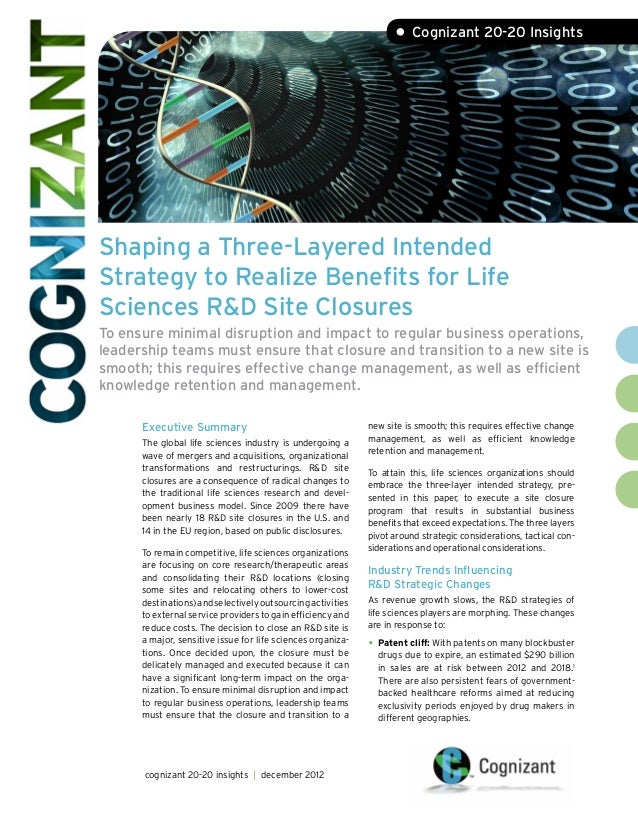
Shaping a Three-Layered Intended Strategy to Realize Benefits for Life Sciences R&D Site Closures
- 1. • Cognizant 20-20 InsightsShaping a Three-Layered IntendedStrategy to Realize Benefits for LifeSciences R&D Site ClosuresTo ensure minimal disruption and impact to regular business operations,leadership teams must ensure that closure and transition to a new site issmooth; this requires effective change management, as well as efficientknowledge retention and management. Executive Summary new site is smooth; this requires effective change management, as well as efficient knowledge The global life sciences industry is undergoing a retention and management. wave of mergers and acquisitions, organizational transformations and restructurings. R&D site To attain this, life sciences organizations should closures are a consequence of radical changes to embrace the three-layer intended strategy, pre- the traditional life sciences research and devel- sented in this paper, to execute a site closure opment business model. Since 2009 there have program that results in substantial business been nearly 18 R&D site closures in the U.S. and benefits that exceed expectations. The three layers 14 in the EU region, based on public disclosures. pivot around strategic considerations, tactical con- siderations and operational considerations. To remain competitive, life sciences organizations are focusing on core research/therapeutic areas Industry Trends Influencing and consolidating their R&D locations (closing R&D Strategic Changes some sites and relocating others to lower-cost destinations) and selectively outsourcing activities As revenue growth slows, the R&D strategies of to external service providers to gain efficiency and life sciences players are morphing. These changes reduce costs. The decision to close an R&D site is are in response to: a major, sensitive issue for life sciences organiza- • Patent cliff: With patents on many blockbuster tions. Once decided upon, the closure must be drugs due to expire, an estimated $290 billion delicately managed and executed because it can in sales are at risk between 2012 and 2018.1 have a significant long-term impact on the orga- There are also persistent fears of government- nization. To ensure minimal disruption and impact backed healthcare reforms aimed at reducing to regular business operations, leadership teams exclusivity periods enjoyed by drug makers in must ensure that the closure and transition to a different geographies. cognizant 20-20 insights | december 2012
- 2. • Post-merger integration activities or con- Key R&D Site Closures Since 2009 solidation: R&D consolidation is an important aspect of post-merger integration, as it helps Year Companies bolster productivity and reduce costs. For 2009 Pfizer, Merck, Eli Lilly example, in 2009 Pfizer consolidated R&D operations and closed six R&D sites in the UK 2010 GlaxoSmithKline, AstraZeneca, and U.S. following its acquisition of Wyeth. Pfizer, Takeda, Abbott Labs, Sanofi-Aventis, Bayer, Roche,• Shift toward selective outsourcing: Due to Novartis margin pressures driven by higher development 2011 Pfizer, Novartis costs, increasing regulatory compliance costs, reduced R&D budgets, government-enforced 2012 Sanofi, AstraZeneca, Roche price cuts and intellectual-property-related Figure 1 taxation laws, life sciences organizations have gradually embraced cost-reduction strategies such as selective outsourcing of R&D activities laborative approach, with selective outsourcing to academic institutions (early stage research) and “open innovation,” are gradually phasing out and contract research organizations (CROs). oversized facilities, which is creating greater job insecurity across the industry.• Pipeline deficiencies: In the past, life sciences organizations relied on a robust pipeline of new Typical site closure activities run the gamut, from products that opened up new revenue streams exiting the site completely, to reducing its existing to offset revenue lost from patent expiration footprint by exiting partially, or by consolidating of existing products in the market. However, operations across multiple sites. Regardless of a sharp decline in successful innovation due the approach taken, the primary goal is to help to increasingly complex disease targets and the organizations reduce costs, consolidate R&D numerous
http://www.slideshare.net/cognizant/shaping-a-threelayered-intended-strategy-to-realize-benefits-for-life-sciences-rd-site-closures
No comments:
Post a Comment